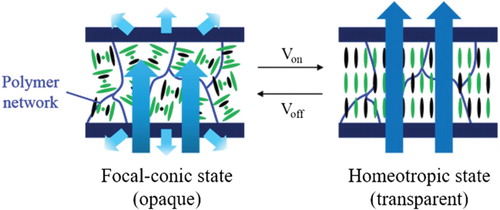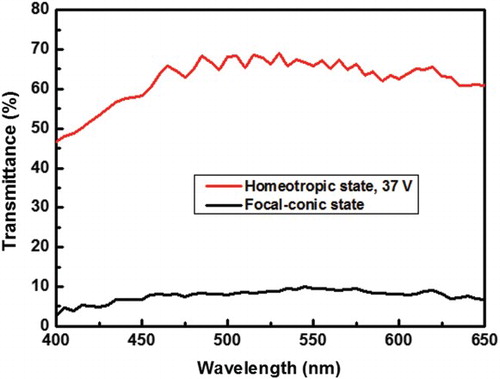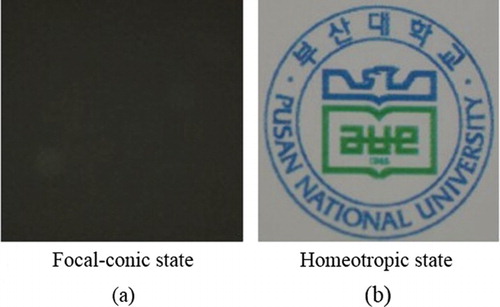ABSTRACT
Proposed herein is a light shutter using dye-doped cholesteric liquid crystals with a polymer network structure for a high-visibility see-through display. The proposed light shutter shows an initially focal-conic state by forming the polymer network structure at the focal-conic state. The proposed light shutter can be easily switched between the focal-conic and homeotropic states without a complicated drive scheme.
1. Introduction
A see-through display using a transparent organic light-emitting diode (OLED) is considered one of the next-generation displays [Citation1,Citation2]. See-through displays, however, suffer from poor visibility because the objects behind them are always seen along with the displayed images because of the transparent window area. In addition, see-through OLED displays cannot provide the black color because they are light-emitting devices. This visibility problem can be overcome by placing a light shutter at the backside of a see-through display. A high-visibility mode can be realized in a see-through display by using a light shutter that masks the objects behind the display with the black color. Through the switching of the light shutter, a see-through display can be operated in the transparent or high-visibility modes.
The operation principle of a light shutter can be classified into two types. Polymer-networked liquid crystal (LC), polymer-dispersed LC, and cholesteric LC (ChLC) devices can be switched by the light scattering effect [Citation3–7]. These devices can mask the objects behind a panel but cannot provide the black color. The suspended-particle, electrochromic, and dye-doped LC devices, on the other hand, can provide the black color [Citation8–11] but cannot mask the objects behind a panel under the bright-environment condition. To realize a high-visibility mode in a see-through display, a light shutter that uses light scattering and absorption effects simultaneously is desirable [Citation12–15]. For this reason, a light shutter using dye-doped ChLCs was proposed [Citation11,Citation15]. The dye molecules strongly absorb the incident light polarized along their absorption axes. The incident light is scattered and absorbed by randomly distributed LC and dye molecules, respectively. Although the dye molecules cannot be switched by the applied field, they are easily aligned along the LC molecules. A dye-doped ChLC device, however, requires a complicated drive scheme for switching from the transparent homeotropic state to the opaque focal-conic state.
In this study, a light shutter using dye-doped ChLCs with the polymer network structure was proposed. The proposed light shutter shows an initially focal-conic state by forming the polymer network structure at the focal-conic state. Switching from the focal-conic state to the homeotropic state can be done by applying a vertical field. When the applied field is removed, the proposed light shutter returns to its initial focal-conic state. Through the formation of a polymer network structure, a ChLC light shutter can be easily switched between the focal-conic and homeotropic states.
2. Operating principle
Figure shows the configuration of a conventional dye-doped ChLC cell. In the initial planar state, the incident light is absorbed by periodically aligned dye molecules. There is no colored reflection in the planar state by Bragg reflection because the reflection wavelength of the ChLC is set to be infrared. It can be switched to the focal-conic state by applying a low voltage. In the focal-conic state, light scattering and absorption occur at the same time owing to the randomly oriented LC and dye molecules. It is stable even after the removal of the applied voltage. Switching to the transparent homeotropic state can be done by applying a high voltage. In the homeotropic state, positive LC and dye molecules are aligned perpendicular to the substrate, which allows most of the incident light to pass through. It returns to the initial planar state when the applied voltage is removed.
For a high-visibility see-through display, a dye-doped ChLC cell can be switched between the opaque focal-conic and transparent homeotropic states, but switching from the homeotropic to the focal-conic state is rather complicated in a conventional ChLC device. Moreover, the planar state of a dye-doped ChLC cell is not used for high-visibility see-through display application. For the simplification of the switching process of a dye-doped ChLC cell, a polymer network structure was formed in the focal-conic state.
Figure shows the configuration of the proposed light shutter. Through the formation of the polymer network structure in the focal-conic state, the planar state of ChLC can be eliminated. Therefore, the proposed light shutter shows an initially opaque focal-conic state. It can provide the black color and can mask the objects behind a panel in the initial state. When a high voltage is applied to the proposed light shutter, it is switched to the transparent homeotropic state. The proposed light shutter relaxes back to the focal-conic state from the homeotropic state when the applied voltage is removed. The proposed light shutter can be easily switched, without a complicated drive scheme, between the focal-conic and homeotropic states by forming a polymer network structure.
3. Cell fabrication
To fabricate a ChLC cell, positive LC (E7, ne: 1.7578, no: 1.5252, Δ: 14.1, Merck) was mixed with chiral dopant (S-811, Merck). The wavelength of the reflected light was set to be 2000 nm. The LC mixture was doped with 2 wt% black dye (S-428, Mitsui) for light absorption. To form a polymer network structure, 2 wt% reactive monomer (RM257, Merck), and 0.1 wt% photoinitiator (Irgacure 651, Ciba) were additionally mixed with the dye-doped ChLC, and then the dye-doped ChLC was exposed to 10-mW/cm2-intensity UV radiation for 10 min in the focal-conic state. The gap between the top and bottom indium-tin-oxide glass substrates was maintained at 10 µm by using ball-type silica spacers without any alignment layer.
4. Experiment results and discussion
The transmission spectra of the proposed light shutter, ranging from 400 to 650 nm, were measured using a collimated white-light source (MC-916C, Photal Otsuka Electronics), as shown in Figure . The initial focal-conic state showed 7.9% transmittance due to the light scattering and absorption that occurred at the same time. When 37 V was applied to the fabricated cell, it was switched to the homeotropic state, with minimum light scattering and absorption. The measured transmittance in the homeotropic state was 62.1%.
Test cells with three different amounts of chiral material were fabricated to observe the pitch dependence of the haze and the specular transmittance. The solid lines in Figure show the measured haze and specular transmittance of the dye-doped ChLC cells with a polymer network structure. In the initial focal-conic state, the fabricated cells showed high scattering effects because the LC and dye molecules were randomly distributed. As the number of pitches increased, the measured haze in the focal-conic state slightly increased as well due to the decreased LC domain size, as shown in Figure (a), whereas there was very weak scattering in the homeotropic state regardless of its pitch because the LC and dye molecules were uniformly aligned. In the homeotropic state, the measured specular transmittances of the fabricated cells were almost the same as the same amount of dyes was used, as shown in Figure (b). As the number of pitches increased, however, the operating voltage increased as well owing to the increased amount of chiral dopant, whereas as the number of pitches increased, the measured specular transmittance in the focal-conic state decreased owing to the increased haze.
Figure 4. Measured haze and specular transmittance of the fabricated cells with a polymer network structure (solid lines) and without a polymer network structure (dotted lines).
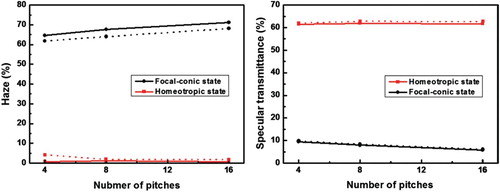
Dye-doped ChLC cells without a polymer network structure were also fabricated to confirm the effect of the polymer network. The dotted lines in Figure show the measured haze and specular transmittance of a dye-doped ChLC cell without a polymer network structure. No degradation of the performance in haze and specular transmittance resulted from the use of a polymer network structure, but the operating voltage increased when a polymer network structure was used, as shown in Table . Nevertheless, the ChLC can be easily switched between the focal-conic and homeotropic states by employing a polymer network structure. A polymer-networked ChLC light shutter can be switched between the homeotropic and focal-conic states by applying or removing the voltage.
Table 1. Operating voltage of the fabricated cells.
The contrast ratios of the fabricated cells with and without a polymer network structure were measured, as shown in Figure . As the number of pitches increased, the contrast ratio of the fabricated cells also increased due to the decreased specular transmittance in the focal-conic state. When the number of pitches was the same, the contrast ratios of the fabricated cells with and without a polymer network structure were the same.
Figure 5. Contrast ratio vs. number of pitches of the fabricated cells with and without a polymer network structure.
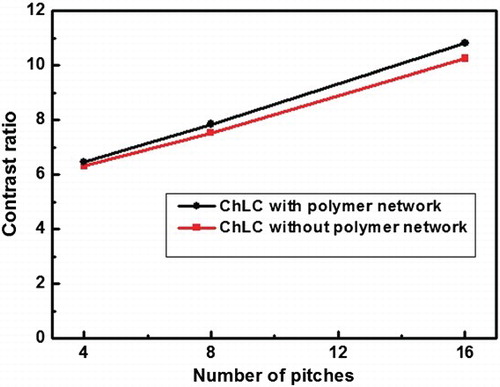
To identify the effect of the dye molecules, an additional polymer-networked ChLC cell without dye molecules was fabricated. Figure (a,b) shows the measured haze, total transmittance, and specular transmittance of the polymer-networked ChLC cells with and without dye molecules, respectively. The measured haze values of the fabricated cells were rarely affected by dye doping, but the measured total and specular transmittances were considerably affected. In the initial focal-conic state, the measured total and specular transmittances of a dye-doped cell was much lower than those of the cell without dye molecules due to the light absorption by the dye molecules, as summarized in Table . By doping an LC light shutter with dye molecules, a superior opaque state can be realized therein. The total and specular transmittances of the transparent homeotropic state also decreased by 22%, however, due to the light absorption by the dye molecules.
Figure 6. Measured haze, specular transmittance, and total transmittance of the polymer-networked ChLC cells (a) with and (b) without dye molecules.
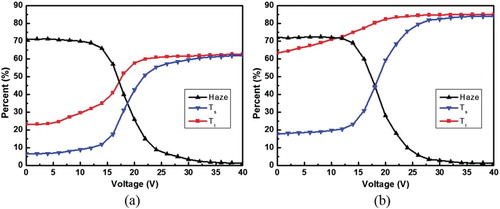
Table 2. Measured haze, specular transmittance, and total transmittance of the polymer-networked ChLC cells in the focal-conic and homeotropic states with and without dye molecules.
Figure shows photographs of the proposed light shutter in the focal-conic and homeotropic states. The fabricated cell was placed on a backlight unit, and a printed transparent film was sandwiched between the cell and the unit. In the focal-conic state, the proposed device was found to be completely capable of masking the objects behind a see-through display with the black color, as shown in Figure (a), because the light scattering and absorption effects occurred simultaneously. When a high voltage was applied, the LC and dye molecules were aligned vertically on the substrate, and the incident light was allowed to pass through. Figure (b) shows the transparent homeotropic state of the fabricated cell.
5. Summary
In summary, proposed herein is a light shutter using dye-doped ChLCs with a polymer network structure. The proposed light shutter shows the initially focal-conic state by forming a polymer network structure at the focal-conic state. Switching between the opaque focal-conic state and the transparent homeotropic state can be easily done by applying a vertical electric field. The transparent display mode or the high-visibility display mode can be chosen in a see-through display by switching the proposed device between the focal-conic and homeotropic states. It is expected that the proposed light shutter can be a new candidate for a smart window technology.
Additional information
Notes on contributors

Byeong-Hun Yu
Byeong-Hun Yu received his B.S. Electronics Engineering degree from Pusan National University, Busan, South Korea, in 2011 and is currently working toward a Ph.D. Electronics Engineering degree. His research interests are the liquid crystal light shutter for see-through displays, and next-generation displays.

Seong-Min Ji
Seong-Min Ji received his B.S. Electronics Engineering degree from Pusan National University, Busan, South Korea, in 2015, where he is currently working towards an M.S. degree. His research interests are the liquid crystal light shutter for see-through displays, and next-generation displays.

Jin-Hun Kim
Jin-Hun Kim received his B.S. Electronics Engineering degree from Pusan National University, Busan, South Korea, in 2016, where he is currently working toward an M.S. degree. His research interests are the liquid crystal light shutter for see-through displays, and next-generation displays.

Jae-Won Huh
Jae-Won Huh received his B.S. Electronics Engineering degree from Pusan National University, Busan, South Korea, in 2013, where he is currently working toward a Ph.D. degree. His research interests are the liquid crystal light shutter for see-through displays, and next-generation displays.

Tae-Hoon Yoon
Tae-Hoon Yoon received his B.S. Electronics Engineering degree from Seoul National University in 1979, and his M.S. and Ph.D. Electrical Engineering degrees from Korea Advanced Institute of Science and Technology (KAIST) in 1982 and 1986, respectively. Since 1986, he has been with the Department of Electronics Engineering of Pusan National University in Busan, South Korea, where he is currently a professor. From 2001 to 2003, he served as the full-time program director of the Information & Electronics Program of Korea Institute of S & T Evaluation and Planning. His current research interests include the optical design of liquid crystal displays, the liquid crystal light shutter, and the fast switching of liquid crystals. Dr Yoon chaired the Program Committee of IMID (International Meeting on Information Display) 2010. He also chaired the Executive Committee of IMID 2011. In 2012, he served as the president of the Optical Society of Korea. Since 2014, he has been the editor-in-chief of the Journal of Information Display. He also served as the chair of the Organizing Committee of ACLC (Asian Conference on Liquid Crystals) 2015.
References
- G. Gu, V. Bulović, P.E. Burrows, S.R. Forrest and M.E. Thompson, Appl. Phys. Lett. 68, 2606 (1996). doi: 10.1063/1.116196
- C.W. Tang and S.A. VanSlyke, Appl. Phys. Lett. 51, 913 (1987). doi: 10.1063/1.98799
- J.W. Doane, N.A. Vaz, B.-G. Wu and S. Žumer, Appl. Phys. Lett. 48, 269 (1986). doi: 10.1063/1.96577
- J.W. Lee, J.K. Kim, F. Ahmad, M. Jamil and Y.J. Jeon, Liq. Cryst. 41, 1109 (2014). doi: 10.1080/02678292.2014.904013
- Y. Geng, P. Brogueira, J.L. Figueirinhas, M.H. Godinho and P.L. Almeida, Liq. Cryst. 40, 769 (2013). doi: 10.1080/02678292.2013.783137
- R.A.M. Hikmet, J. Appl. Phys. 68, 4406 (1990). doi: 10.1063/1.346190
- D.-K. Yang, J.L. West, L.-C. Chien and J.W. Doane, J. Appl. Phys. 76, 1331 (1994). doi: 10.1063/1.358518
- R. Vergaz, J.-M. Sánchez-Pena, D. Barrios, C. Vázquez and P. Contreras-Lallana, Sol. Energ. Mat. Sol. C. 92, 1483 (2008). doi: 10.1016/j.solmat.2008.06.018
- D. Barrios, R. Vergaz, J.M. Sanchez-Pena, C.G. Granqvist and G.A. Niklasson, Sol. Energ. Mat. Sol. C. 111, 115 (2013). doi: 10.1016/j.solmat.2012.12.012
- A. Azens and C. Granqvist, J. Solid State Electr. 7, 64 (2003). doi: 10.1007/s10008-002-0313-4
- B.-H. Yu, J.-W. Huh, K.-H. Kim and T.-H. Yoon, Opt. Express 21, 29332 (2013). doi: 10.1364/OE.21.029332
- J.-W. Huh, B.-H. Yu, J. Heo and T.-H. Yoon, Appl. Opt. 54, 3792 (2015). doi: 10.1364/AO.54.003792
- J. Heo, J.-W. Huh and T.-H. Yoon, AIP Advances 5, 047118 (2015). doi: 10.1063/1.4918277
- J.-W. Huh, S.-M. Ji, J. Heo, B.-H. Yu and T.-H. Yoon, J. Disp. Technol. 12, 779 (2016). doi: 10.1109/JDT.2016.2537827
- B.-H. Yu, J.-W. Huh, J. Heo and T.-H. Yoon, Liq. Cryst. 42, 1460 (2015). doi: 10.1080/02678292.2015.1061149


